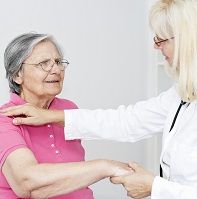Article
In-Clinic Compared to Telerehabilitation for Stroke Patients
Author(s):
A recent study found that telerehabilitation was comparable to traditional in-clinic rehabilitation for stroke patients.

A recent study has found that home-based telerehabilitation (TR) is non-inferior to in-clinic (IC) therapy for patients after suffering from a stroke.
Patients in the TR group saw a greater mean score change when investigators examined change in arm function among patients who had suffered a stroke within the past 4 to 36 weeks.
“The promise of Telehealth is we can gives them gobs of practice in an accessible way. We could go hours a day for weeks and months on end,” said Steven Cramer, MD, professor of neurology at UC Irvine. “This is exciting, not just because we showed comparable efficacy but it opens the door to taking this up to a whole new level.”
Investigators sought to determine whether treatment delivered through a home-based tele rehabilitation system had comparable efficacy with a dose-matched, intensity-matched therapy in an in-clinic setting. Investigators also sought to examine whether this system had comparable efficacy for providing stroke education.
Investigators identified 124 patients from 11 US sites with arm motor deficits, as defined by a Fulg-Meyer (FM) score between 22 and 56 of 66, 4 to 36 weeks after stroke onset. The primary end point was within-patient change in arm motor FM score.
Patients were randomized in 1:1 ratio to receive intensive arm motor therapy IC (n=62) or using TR (n=62) at the patient’s home. Investigators noted that therapy intensity, duration, and frequency were matched across the 2 treatment groups. The study used an assessor-blinded, randomized, controlled, noninferiority design to test whether efficacy is compared between the 2 groups.
In order to be included in the study, patients had to meet several criteria. Patients must have been 18 years or older, had experienced ischemic stroke or intracerebral hemorrhage 4 to 36 weeks prior, had mild to severe arm motor deficits, and had no major deficits in mood or cognition. All patients underwent baseline testing and were randomized using a web-based central system.
Among patients who initiated at least 1 treatment session, those in the TR group were adherent with 98.3% of assigned therapy sessions (35.4 of 36). Authors noted that those in the IC group were adherent with 93.3% (33.6 of 36) of therapy sessions.
Of the 124 participants, the mean age was 61, 90 were men, and the mean baseline FM score was 43 points. Patients in the IC group had a mean FM score change of 8.36 points from baseline to 30 days after therapy. In the TR group, the mean change was 7.86 points at 30 days. The covariate-adjusted mean FM score change was 0.06 points higher in the TR group.
Investigators noted that the noninferiority margin was 2.47 and fell outside of the 95% confidence interval, which indicates that TP is not inferior to IC therapy. Additionally, motor gains remained significant when patients were enrolled early or late after stroke were examined separately by investigators.
Authors noted multiple limitations within their study. The focus of the study was on arm motor deficits and there are many other deficits that can also benefit from high-dose rehabilitation. Additionally, no economic analysis was performed for this trial and performances on the stroke education quiz were high in both groups at baseline — preventing investigators from detecting a difference between groups in gains in stroke knowledge.
This study, titled “Efficacy of Home-Based Telerehabilitation vs In-Clinic Therapy for Adults After Stroke,” is published in JAMA Neurology.





